
Shirebrook is a town in the Bolsover District of Derbyshire, England. It had a population of 13,300 at the 2021 Census. The town is on the B6407 road and close to the A632 road which runs between the towns of Mansfield, Worksop and Bolsover. The town is close to the Bassetlaw and Mansfield Districts of Nottinghamshire.

Shirebrook railway station serves the town of Shirebrook in Derbyshire, England. The station is on the Robin Hood Line, 21½ miles (35 km) north of Nottingham towards Worksop.

Mansfield Woodhouse railway station serves the settlement of Mansfield Woodhouse, which adjoins the town of Mansfield, both located in Nottinghamshire, England.

The Great Central Main Line (GCML), also known as the London Extension of the Manchester, Sheffield and Lincolnshire Railway (MS&LR), is a former railway line in the United Kingdom. The line was opened in 1899 and built by the Great Central Railway running from Sheffield in the North of England, southwards through Nottingham and Leicester to Marylebone in London.
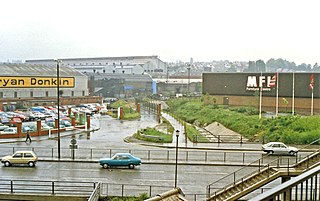
Chesterfield Market Place railway station was a former railway station in the centre of the town of Chesterfield, Derbyshire, England.
The Lancashire, Derbyshire and East Coast Railway (LD&ECR) was built to connect coalfields in Derbyshire and Nottinghamshire with Warrington and a new port on the Lincolnshire coast. It was a huge undertaking, and the company was unable to raise the money to build its line. With the financial help of the Great Eastern Railway it managed to open between Chesterfield and Lincoln with a branch towards Sheffield from 1896. Despite efforts to promote tourist travel, the passenger business was never buoyant, but collieries were connected to the line, at first and in succeeding years. The Great Eastern Railway, and other main line companies, transported coal to the southern counties, and the company's engines took coal to Immingham in great quantities. The company had a fleet of tank engines.

Shirebrook North railway station was a railway station serving the town of Shirebrook in Derbyshire, England. It was on the Lancashire, Derbyshire and East Coast Railway running from Chesterfield to Lincoln. The station was also on the former Shirebrook North to Nottingham Victoria Line and the Sheffield District Railway. The station has since been demolished and housing now occupies parts of the site with some stub rails nearby serving a train scrapper.
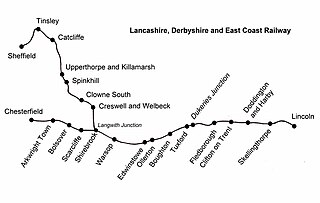
Warsop railway station is a former railway station in Market Warsop, Nottinghamshire, England.
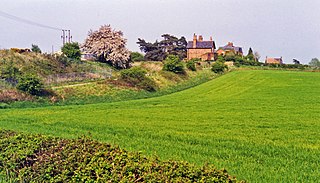
Edwinstowe railway station is a former railway station in Edwinstowe, Nottinghamshire, England.
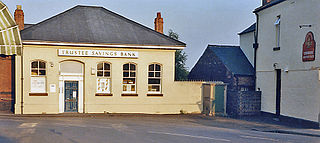
Clowne South railway station is a former railway station in Clowne, Derbyshire, England.

The Nottingham Suburban Railway was a British railway company that constructed a line 3.65 miles (5.87 km) in length serving the north-eastern suburbs of Nottingham. It was built to shorten the distance by train to Ilkeston and towns on the Leen Valley railway line, and to connect important brickworks near Nottingham. The short line was expensive to build due to difficult topography; it opened in December 1889, and was worked by the Great Northern Railway; the trains used that company's Nottingham terminus.

Pleasley West was a railway station on the Doe Lea line in Pleasley, Derbyshire, England on the border of Derbyshire and Nottinghamshire. It opened in 1886 and closed to scheduled services in 1930, though it was served by excursion trains until 1964.
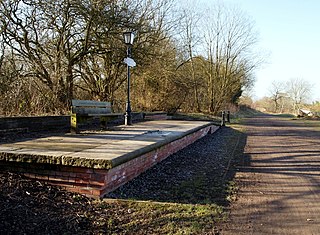
Teversall Manor is a former railway station in Teversal, Nottinghamshire on the Derbyshire border west of Mansfield.
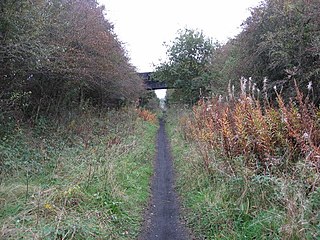
Pleasley East is a former railway station in Pleasley, Derbyshire, England on the Nottinghamshire border near Mansfield.
Markland Grips Viaduct is a former railway viaduct south east of Clowne, Derbyshire, England.
The Doe Lea branch is a mothballed railway line in Derbyshire, England. It connected the Derbyshire towns of Chesterfield, Staveley and Bolsover to the Nottinghamshire town of Mansfield. It also had a branch line to Creswell via the Derbyshire town of Clowne.
Beighton Junction is a set of railway junctions near Beighton on the border between Derbyshire and South Yorkshire, England.
The Leen Valley lines of the Great Northern Railway were railway branch lines built to access the collieries in the Nottinghamshire coalfield in England. The Midland Railway had long been dominant in the area, but there was resentment against its monopolistic policies from coalowners, who encouraged the Great Northern Railway to build a line. The Leen Valley Line was opened in 1881; it ran as far as Annesley colliery. A passenger service was run the following year, and very considerable volumes of coal were hauled.
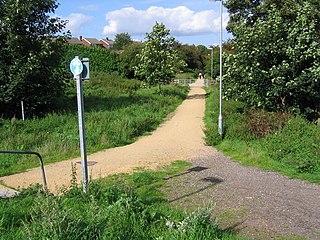
Skeby railway station served the village of Skegby, Nottinghamshire in England.

Sutton-in-Ashfield Town railway station or simply "Sutton Town" railway station served the market town of Sutton-in-Ashfield, Nottinghamshire in England.
















